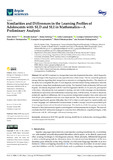| dc.contributor.author | Bonti, Eleni | |
| dc.contributor.author | Kamari, Afroditi | |
| dc.contributor.author | Sofologi, Maria | |
| dc.contributor.author | Giannoglou, Sofia | |
| dc.contributor.author | Porfyri, Georgia-Nektaria | |
| dc.contributor.author | Tatsiopoulou, Paraskevi | |
| dc.contributor.author | Kougioumtzis, Georgios | |
| dc.contributor.author | Efstratopoulou, Maria | |
| dc.contributor.author | Diakogiannis, Ioannis | |
| dc.date.accessioned | 2022-01-12T08:42:45Z | |
| dc.date.available | 2022-01-12T08:42:45Z | |
| dc.date.issued | 2021-06 | |
| dc.identifier.issn | 2076-3425 | |
| dc.identifier.uri | http://hdl.handle.net/11728/12075 | |
| dc.description.abstract | SLI and SLD constitute two independent neurodevelopmental disorders, which frequently cause challenges in the diagnosis process, especially due to their nature. This has caused disagreement among clinicians regarding their recognition as separate or overlapping disorders. The objective of the study was to enlighten the path of valid diagnosis and intervention during adolescence when the two disorders change their manifestation and overlap. Two hundred Greek adolescents (140 boys and 60 girls), 124 already diagnosed with SLD and 76 diagnosed with SLI, 12-16 years old, participated in the study. All participants were assessed in reading, oral and written language and mathematics (mathematical operations and mathematical reasoning) along with IQ testing. In order to determine statistically significant differences, the chi-square test, independent samples t-test, odds ratios and their 95 per cent confidence intervals were implemented. The results revealed that the SLI group presented significantly greater difficulties than SLD in their overall cognitive-mental profile and in most language and mathematical measurements (number concept, executive-procedural part of solving operations and mathematical reasoning). The similarity of the two groups was mainly detected in their deficient metacognitive, metalinguistic and metamnemonic strategies. The research concludes that SLD adolescents managed to overcome their difficulties to a significant degree, while adolescents with SLI still struggle with many learning areas. | en_UK |
| dc.language.iso | en | en_UK |
| dc.relation.ispartofseries | Brain Sciences;Volume 11, Issue 7 | |
| dc.rights | © The Author(s) | en_UK |
| dc.rights.uri | http://creativecommons.org/licenses/by-nc-nd/4.0/ | en_UK |
| dc.subject | SLD | en_UK |
| dc.subject | SLI | en_UK |
| dc.subject | adolescence | en_UK |
| dc.subject | learning profiles | en_UK |
| dc.subject | neurodevelopmental disorders | en_UK |
| dc.subject | specific learning disabilities in mathematics | en_UK |
| dc.title | Similarities and Differences in the Learning Profiles of Adolescents with SLD and SLI in Mathematics—A Preliminary Analysis | en_UK |
| dc.type | Article | en_UK |
| dc.doi | 10.3390/ brainsci11070850 | en_UK |


